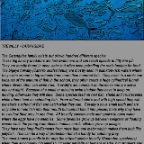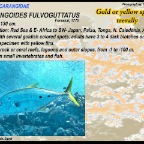Trevally - Carangidae
TREVALLY - CARANGIDAE
The Carangidae family are one of approximately two hundred different species. These big silvery predators are fast swimmers and can reach speeds of fifty Km p/h. They are mostly found in open water but can often be seen patrolling the reefs looking for food. The bigeye trevally (Caranx- sexfasciatus) are mostly seen in plankton-rich waters where they swim around in big schools of more than hundred fish. They swim in circles and because of the amount of fish in a school, can often create a huge cylindrical funnel where divers can sometimes swim through. Trevallies are constantly on the move and are active both day and night. They are missing, or only have a small swim bladder, so have to keep on moving, or they will sink. Some species feed on reef fish, shells and crustaceans while others feed on schooling fish. Working from different sides and at high speed they will penetrate a school of fish and catch what they can. Trevallies have small teeth and are able to hold fish into their mouth, but cannot bite it into pieces. This is the reason they have to swallow their prey whole. All trevally species mate and spawn in open water as the eggs will not have predators. Some juveniles grow up between seagrass or floating weeds, while the young from Alectis indicus and A. ciliatus grow up pelagic. They have very long fin-filaments of more than a meter which can make them look like jellyfish. This can be a way of protection but also handy for catching prey. The most common juvenile is the striped golden trevally (Gnatodon speciosus) that accompanies big jellyfish, Oceanic whitetip or leopard sharks, big groupers and whalesharks. The reason why they are often seen with sharks is because they use the shark’s rough skin to get rid of their parasites by rubbing themselves against them. Length: 22 cm.Distribution: from the Persian Gulf to S.W- Japan, Papua New Guinea and N- Australia.Silvery body with broad yellow stripe from above eye’s to tail, often with dark spot on rear edge of gill cover. Form large schools, above soft bottoms, in mid-water along coastal areas to -20 m. Length: 53 cm.Distribution: from the Red Sea to Papua New Guinea, Philippines and Seychelles.Silvery groundcolour with orange spots on the sides, occasionally almost completeorange-yellow. Lives solitary or in groups along coastal reefs and outer slopes, from-2 to -50 m. A fast swimming predator, feeds on fishes. Length: 140 cm.Distribution: Red Sea to Panama, SW- Japan, Hawaii, New Caledonia and G.B.R.From silvery-yellow to silver with 7 to 11 black bars. These bars fade with maturity.Yellow fins, pectoral fins are hook-shaped. Small juveniles below 5cm live among the tentacles of jellyfish, larger juveniles often accompany large pelagic fishes.Lagoons, coastal- and outer reefs. They feed on invertebrates. Length: 120 cm.Distribution: circumtropical. Slender silvery-blue body with 2 light blue lines from head to tail, often with broadyellow line in between. Long forked tail. Feeds on pelagic crustaceans and small fish.Sometimes solitary but mostly in schools, often together with other Carangidae likeon the right photograph. Pelagic and on outer reefs, from surface to -150 m. Length: 46 cm.Distribution: S- Africa to S- Japan, Philippines, ?. California, Alaska, Bering Sea.Silver colour, quite large eyes and a gold coloured curved line next to gill cover.A coastal and schooling species. Known from the famous “sardine run” bait balls at South Africa. From 0 to -475 m. Length: 165 cm.Distribution: Red Sea and E- Africa to SW- Japan, Hawaii, Fr.Polynesia and Australia.Silver colour with numerous small black spots, steep forehead.Small black area above pectoral fin. Single row of canines in each jaw.Feeds primarily on small fishes and crustaceans. Adults, solitary in lagoons and seaward reefs down to -80 m. Juveniles, near sandy inshore or estuarine areas. Length: 70 cm.Distribution: Red Sea and E- Africa to SW- Japan, Hawaii and New Caledonia.Silvery-blue with yellowish fins. Tail fin with black margin.They usually display five to seven vertical bars, can be very pale. Above sandy areas.Swims in schools, in open water of lagoons and outer reefs, from -1 to -60 m. Length: 80 cm.Distribution: from the Red Sea to Panama, S- Japan and New Caledonia.Eye relatively big, dark spot on upper edge of opercle, white tip on second dorsal fin.Adults generally in schools by day along lagoon, channel or seaward reef dropoffs,from 1 to -90 m. Feeds primarily at night on fishes and crustaceans. Juveniles in shallow inshore areas.























